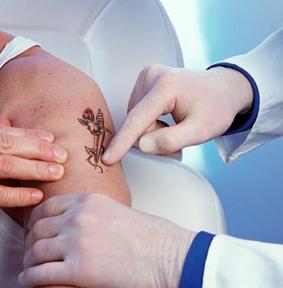With tattoos exploding in popularity over the last 10 to 20 years, so too has the number of people seeking laser treatment for tattoo removal, reports the Cosmetic Physicians Society of Australasia (CPSA) whose members have seen a 15-20 per cent increase in requests for this procedure in the last three years.

Estimates suggest that more than 2.2 million Australians, or one in 10 people, have a tattoo*. However, what may seem like a good idea in your late teens or early twenties may not seem so relevant in later life and can even limit career opportunities.
Dr Susan Austin, spokesperson from the CPSA says: “Tattoos have not only become mainstream but perhaps even aspirational to some people, as many high profile celebrities and athletes sport prominent tattoos. However, there are certainly a lot of people who are now realising that something that may have been pertinent or significant to them at one period of their lives, is no longer relevant or they simply may not like their tattoo anymore. Tattoos can also limit employment opportunities as some organisations have policies that do not allow employees to have visible tattoos.
“What people should consider before they get a tattoo is that the removal process can be quite painful and expensive. A number of factors can also affect the efficacy of treatments including the types of colour in the tattoo and the placement of the tattoo itself,” says Dr Austin.
The typical course of treatment for tattoo removal involves the use of lasers, which work by breaking down the ink particles in the skin. The more colours in a tattoo, the more difficult it is to remove as different types of lasers are needed to break down the vast range of coloured ink particles.
“As lasers operate on different frequencies, they can only target specific colours, which makes it more difficult to remove multi-coloured tattoos,” says Dr Austin. “The cost of treatment will vary with the size of the tattoo but will generally start from $200.” In addition to being quite painful and expensive, the removal process for tattoos is quite lengthy. “While it may only take a few hours to get a tattoo, it takes much longer remove it. Most tattoos require around ten or more sessions to be removed,” says Dr Austin.
While laser technology does continue to improve, for some patients, their tattoos will never be completely erased and the removal process can cause changes in the colour of their skin and, in rare cases, scarring. “Sometimes lasers can affect skin pigment, which means that as the lasers break down the ink particles, they may also affect the melanin, or the brown colour, of the skin itself. The result of this is that some patients have a lighter patch of skin where the tattoo used to be compared to the surrounding area. For some people this is a temporary side effect but for others, it can be permanent. For some, the tattoo process itself may also cause scarring and this will still be present when the colour is removed,” says Dr Austin.
Another important consideration when having a tattoo removal treatment is choosing the right medical professional to complete the treatment.
“The use of lasers is largely unregulated in most parts of Australia, which means that anyone can purchase a laser device and begin operating. As tattoo removal can be quite a lengthy and complicated process, we strongly recommend that intending patients research the qualifications of the operator and consult with a medical professional to ensure that they are getting the right treatment,” adds Dr Austin.
Patients interested in finding a doctor that offers tattoo removal treatments can visit www.cosmeticphysicians.org.au
*Communicable Diseases Intelligence, Volume 25, Issue number 2 – April 2001, ‘Prevalence of tattooing and body piercing in the Australian community’, www.health.gov.au/internet/main/publishing.nsf/content/cda-pubs-cdi-2001-cdi2502-cdi2502i.htm

